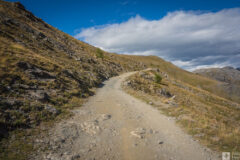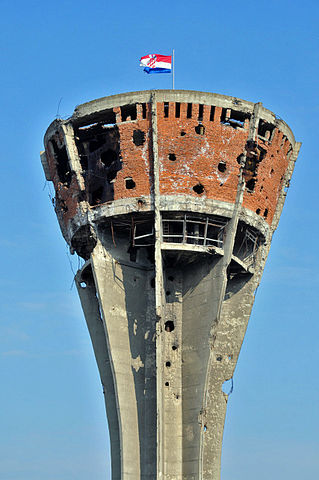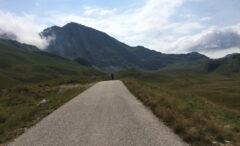This page contains information about the 2015 Transcontinental Race No. 3. See the Overview page for a general introduction to the Transcontinental Race (TCR). See also the official TCR page.

Page Contents:
Route Summary
The map towards the bottom of this page shows the simplified routes. For the first time, the race started in mainland Europe instead of the UK, so the complication of choosing and timing a ferry crossing to France were avoided. The starting venue was the Muur van Geraardsbergen in Belgium, which had been a checkpoint in the first edition of the race. The race started with a short loop around the town before climbing the cobbled classic. Here is the footage from my on-bike camera:
Instead of the morning start used for the London departures, the race started at midnight on 25th July, 2015. People therefore had to choose whether to rest the first night or push straight through, most chose the latter option. There was some rain in the early morning and strong, gusty side-winds. The second night was much clearer and cooler than the first, with temperatures approaching 5 degrees C for those who were still in northern France.
The first checkpoint was much farther from the start than it had been in previous years, with riders needing to cover about 950 km to get to Mont Ventoux. The field spread out across northern and eastern France, then became more tightly packed as they entered the Rhone valley. The leaders all made it to the top of the historic climb up the Giant of Provence from Bedoin by the end of the second day.
To get to the second checkpoint in Sestriere, Italy, the only plausible route was up the Durance valley. When the main road became restricted access with no bicycles allowed, many people remained on it instead of using one of the two alternative back-roads and subsequently received a time penalty. This was the first year that the roads which people used was monitored closely throughout the race by official dot watching volunteers and many penalties were given out when illegal roads were used.
The checkpoint in Sestriere was at the start of the section that had caused people the most anguish when choosing their equipment. The Strada dell’Assietta is an old military road along the top of a mountain ridge, and when combined with the gravel descent of the Colle delle Finestre, it meant doing about 40 km of dirt and gravel roads that were mostly above 2000 meters elevation. Everyone knew that it would be unpaved, but many people were not prepared for just how rough it would be on a road bike. Even the fastest people took 3 hours to traverse the short distance, but many others took a lot longer due to punctures and having to walk up and down some of the steeper sections.
After leaving the Alps via Torino, there was 600 km of riding to do across the uninteresting northern Italian plains to get to Slovenia. The front runners again had the best of the weather, while everyone in the mid-pack battled strong, demoralizing headwinds for a couple of days.

The next checkpoint was in Vukovar in eastern Croatia on the Danube river. The town was under siege by the Serbian forces after Yugoslavia was dissolved in the early 1990s, and evidence from the battles is still apparent on some buildings, particularly the town’s water tower.
A few cunning people decided to adopt an entirely different approach and reversed the order of checkpoints 3 and 4. They went down the Italian Adriatic coast to Ancona and took the same overnight ferry to Split that so many people had taken in the 2014 race. From Split, it wasn’t far to checkpoint 4, which, as in 2014, was Mount Lovćen in Montenegro. They then traversed Bosnia in the reverse direction to get to Vukovar. From Vukovar, they were on the same trajectory to Istanbul that most people had used in TCR No. 1 in 2013. In total, people using this route had slightly less distance to ride and had fewer headwinds, but they had to time their arrival for the ferry well to avoid losing time.
When traversing Croatia and Bosnia, many people followed the more major arteries that lead through Zagreb and Sarajevo, but there were equally good options that avoided the big cities. After Sarajevo, many people tried to take a direct route instead of staying on the main roads, but soon discovered that it was a rough dirt road and lost significant time. This included the leader of the race, Josh Ibbett, who turned around before the road got too bad and returned to the main road, by which time he had lost all but just a few kms of his lead, but the man that he had battled with for the lead for the previous few days, James Hayden, had to drop out soon after due to Shermer’s Neck.
The route options for the final section between Mount Lovćen and Istanbul were well known from the previous edition of the race. Again, the routes basically boiled down to Highway 8 in Bulgaria or Highway 2 in Greece due to the Rhodope mountains being in between. Many of the people who chose to go through Greece had to contend with a lot of headwind and intense heat in the middle of the day. The typical total distance ridden was much further than previous editions at over 4200 km.
I had to scratch near the Slovenian border, but flew out to Istanbul to see everyone finish, including my friend Alain Rumpf. I joined him for the final 20 km of the route through the Belgrad Forest and then the wild ride along the Bosphorous Strait, as shown in this video.
To view specific rider tracks, go to Trackleaders and click on the T button at the top of the map. Here is the simplified map:
Application Process
The number of starting places available increased from 101 in 2014 to 250 in 2015. This consisted of 150 solo places and 100 places in the new pairs category (50 pairs). For the first time, people had to complete a questionnaire to register for the race that tested their awareness of what the race entailed and what unsupported means. Applications were open for about one week in November and about 350 were received, so the responses to the questionnaire plus a lottery process was used to award starting places during December, although all veterans who asked to return were automatically given a place. When people withdrew, some places were re-assigned to those on the waiting list during the Spring. 172 people made it to the start line.
During the application process, what being self-supported meant was highlighted strongly and much more emphasis was put on this in the manual and during the riders’ briefing. Volunteer dot watchers were used for the first time to closely monitor where people were riding, whether they were spending extended periods of time with other riders, and whether they were receiving external strategic support on social media.
Results Highlights
The official results are here. The far longer route of this edition compounded by the headwinds meant that a lower proportion than ever before finished the race: just 89 of the 172 starters (52%). Only 36 finishers arrived in time for the party (21% of all starters).
Kristof Allegaert (BEL) had dominated the first two editions of the race, but he was busy riding the TransSiberia race in Russia, which he also won. So the TCR would have a new victor in 2015.
Despite competing for the first time, James Hayden (UK) was the clear leader for the first half of the race, but after being the first rider at CP1 and CP2, he developed Shermer’s Neck. He dropped to 2nd at CP3 behind Josh Ibbett (UK), who finished 2nd the previous year. As the condition got worse, James had to abandon the race after reaching CP4 in 3rd place.
Josh Ibbett went from 3rd at CP1 to 2nd at CP2 to 1st at the last two CPs and the finsih. He won in a time of just under 10 days, more than 31 hours ahead of 2nd place.
Bernd Paul (GER) had reached CP1 at the top of Mont Ventoux in 2nd behind James, but he was suffering from an allergic skin reaction to the sun and had to abandon soon after.
Ultan Coyle (IRE) was in 3rd place at CP2 behind James and Josh, but had chosen to ride a time trial bike for efficiency on the flatter sections of the route. His bike wasn’t the right tool for the gravel roads of the Strada dell’Assietta, so he lost a lot of time there and he was 6th by the time he reached CP3. He was able to come back to finish 4th, missing the tight battle for 2nd and 3rd place by about 3 hours.
Alexandre Bourgeonnier (FRA) made a gradual progression through the top 5, being 5th at CP1, 4th at CP2, 3rd at CP3, 2nd at CP4 and the finish. The podium was complete by Tomas Navratil (CZE), who had been just inside the top 10 throughout and 8th at CP3. From there, he recorded the 2nd fastest time from CP3 to CP4 and to the finish, with only Josh Ibbett being faster, which allowed him to finish 3rd.
As mentioned in the Route Summary section above, some people chose to take a ferry across the Adriatic and reverse the order of CP3 and CP4. The fastest of these 8 people was Gareth Baines (UK), who finished 8th overall, having been 16th at CP2 before taking the ferry route. In future editions, the CPs had to be visited in the official order.
Timothy France (UK) & Neil Phillips (UK) led the pairs category throughout the race and finished in just under 14 days. Only 18 solo riders finished before them.
Out of the 132 solo riders, only 3 were women. The first woman in the 2013 edition, Juliana Buhring (GER), was doing well heading for CP1, but developed knee issues and had to scratch before getting there. Sarah Searle (UK) also scratched before CP1. Emily Chappell (UK) was the only remaining solo female, but she scratched after CP2. Two females started in male-female pairs, but both of those pairs scratched.
Jayne Wadsworth (UK) had started the race in the pairs category with another female, Katie L’Herpiniere (GBR). Katie had to scratch in Albania (after CP4) and Jayne decided to continue on her own to Istanbul. She was therefore the only female to finish, arriving after 16 and a half days. She had been a late replacement for Katie’s original partner less than 2 weeks before the start of the race and had no idea what to expect and didn’t even meet Katie until arriving at the start.
About 65% of the finishers received a time penalty for rule violations (mostly for using prohibited roads). The majority of these were just 1 hour, but some people received up to 6 hours. The penalties did not affect any of the positions within the top 10 solos or pairs, but did alter many positions in the tighter mid-pack.
Race Reports & Media
Official race reports:
Official videos:
- Control 1: Mont Ventoux
- Control 2: Strada dell’Assietta
- Rider Approaching Sestriere
- Lee Pearce at Mount Lovćen
Race reports from individual riders are listed near the top of this page and my own race report is here.
Unofficial reports:
Last significant page update: February, 2023
This page is in the The Transcontinental Race section. The next page in this section is:

